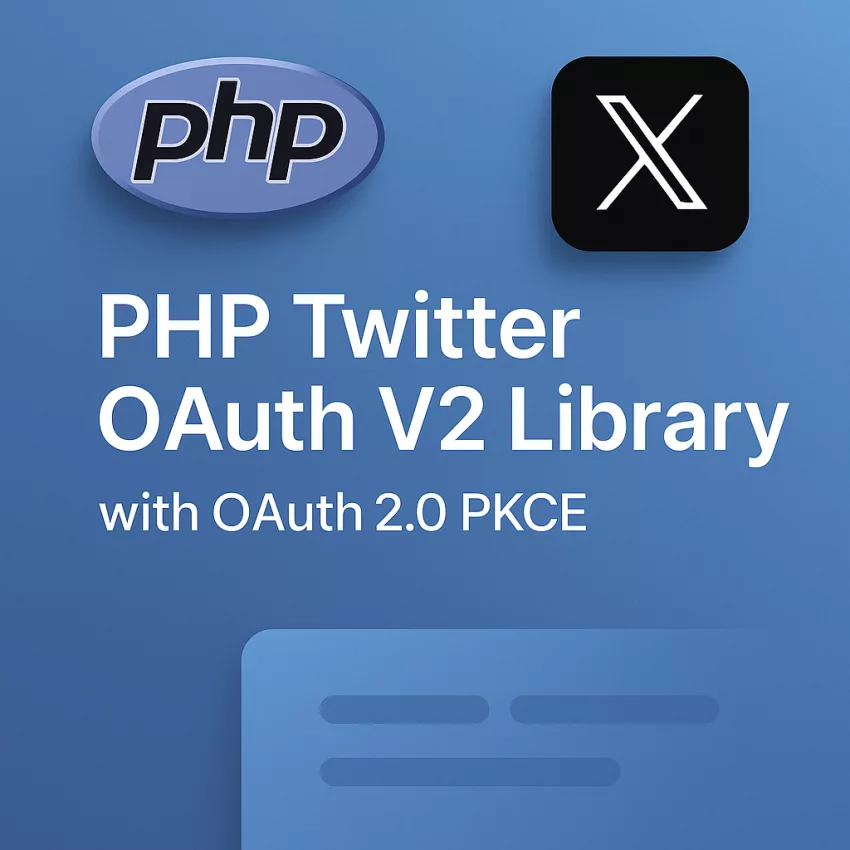Table of Contents
- Introduction
- Prerequisites
- Setting Up the PHP Project
- Implementing OAuth 2.0 Authorization Code Flow with PKCE
- Managing User Sessions
- Interacting with Twitter API v2
- Handling Errors
- Security Best Practices
- Conclusion: Empowering Developers with Twitter OAuth 2.0 in PHP
1. Introduction
OAuth 2.0 is an industry-standard protocol for authorization, allowing applications to access user data without exposing credentials. Twitter’s API v2 supports OAuth 2.0, enabling secure interactions with user accounts. In this tutorial, we’ll utilize the abdulbaquee/twitter-oauth-v2 PHP library to integrate Twitter OAuth 2.0 into a core PHP application.
2. Prerequisites
Before we begin, ensure you have:
- A basic understanding of PHP and OAuth 2.0 concepts.
- Composer installed for dependency management.
- A Twitter Developer account with a registered application.
For detailed steps on setting up a Twitter Developer account and creating an application, refer to the Twitter Developer Documentation
3. Setting Up the PHP Project
a. Install Dependencies
Navigate to your project directory and run:
composer require abdulbaquee/twitter-oauth-v2b. Directory Structure
Organize your project as follows:
/your-project
├── /vendor
│ ├── abdulbaquee/twitter-oauth-v2
├── /src
│ └── Auth.php
├── /public
│ ├── index.php
│ └── callback.php
└── composer.json
4. Implementing OAuth 2.0 Authorization Code Flow with PKCE
The Authorization Code Flow with PKCE enhances security by using a code verifier and challenge. This flow is ideal for web applications.
1. Authentication (Auth.php file)
You only need this file for managing the OAuth 2.0 flow.
<?php
// /src/Auth.php
use AbdulBaquee\TwitterOAuthV2\TwitterOAuthV2;
class Auth {
private $clientId;
private $clientSecret;
private $redirectUri;
// Constructor to initialize clientId, clientSecret, and redirectUri
public function __construct($clientId, $clientSecret, $redirectUri) {
$this->clientId = $clientId;
$this->clientSecret = $clientSecret;
$this->redirectUri = $redirectUri;
}
// Redirect to Twitter's authorization URL
public function redirectToAuthorization() {
$oauth = new TwitterOAuthV2($this->clientId, $this->clientSecret, $this->redirectUri);
$authUrl = $oauth->getAuthorizationUrl();
header('Location: ' . $authUrl); // Redirect user to Twitter for authentication
exit;
}
// Handle callback from Twitter, exchanging the authorization code for access tokens
public function handleCallback($code) {
$oauth = new TwitterOAuthV2($this->clientId, $this->clientSecret, $this->redirectUri);
$accessToken = $oauth->getAccessToken($code);
$_SESSION['access_token'] = $accessToken; // Store access token in session
}
}
2. Index.php (Main Entry Point)
This file will manage the flow for OAuth 2.0 and allow users to interact with Twitter API v2.
<?php
// /public/index.php
require '../vendor/autoload.php'; // Autoload necessary dependencies
require '../src/Auth.php'; // Include Auth.php file for OAuth handling
session_start();
// Initialize Auth object with your client credentials
$auth = new Auth('your-client-id', 'your-client-secret', 'your-redirect-uri');
// Check if user is authenticated by checking the session
if (!isset($_SESSION['access_token'])) {
// If not authenticated, redirect to Twitter authorization
$auth->redirectToAuthorization();
}
// Once authenticated, use the access token to post a tweet (example)
use AbdulBaquee\TwitterOAuthV2\TwitterOAuthV2;
$oauth = new TwitterOAuthV2('your-client-id', 'your-client-secret', 'your-redirect-uri');
$oauth->setAccessToken($_SESSION['access_token']);
$response = $oauth->postTweet('Hello, Twitter!');
print_r($response); // Output the response from Twitter API
3. Callback.php (To Handle the Callback from Twitter)
<?php
// /public/callback.php
require '../vendor/autoload.php'; // Autoload necessary dependencies
require '../src/Auth.php'; // Include Auth.php file for OAuth handling
session_start();
// Check if the authorization code is available in the callback
if (isset($_GET['code'])) {
// Handle the callback and get the access token
$auth = new Auth('your-client-id', 'your-client-secret', 'your-redirect-uri');
$auth->handleCallback($_GET['code']); // Exchange code for tokens
header('Location: /'); // Redirect back to the main page (index.php)
exit;
}
5. Managing User Sessions
Use PHP sessions to store access and refresh tokens securely.
<?php
session_start();
if (!isset($_SESSION['access_token'])) {
header('Location: /login.php');
exit;
}
6. Interacting with Twitter API v2
1. Posting a Tweet
<?php
require '../vendor/autoload.php';
use AbdulBaquee\TwitterOAuthV2\TwitterOAuthV2;
$oauth = new TwitterOAuthV2($clientId, $clientSecret, $redirectUri);
$oauth->setAccessToken($_SESSION['access_token']);
$response = $oauth->postTweet('Hello, Twitter!');
2. Uploading Media
<?php
require '../vendor/autoload.php';
use AbdulBaquee\TwitterOAuthV2\TwitterOAuthV2;
$oauth = new TwitterOAuthV2($clientId, $clientSecret, $redirectUri);
$oauth->setAccessToken($_SESSION['access_token']);
$mediaId = $oauth->uploadMedia('/path/to/image.jpg');
$response = $oauth->postTweet('Check out this image!', ['media' => $mediaId]);
7. Handling Errors
Implement error handling for common issues:
- Token Expiration: Check for 401 Unauthorized errors and refresh tokens as needed.
- Invalid Scopes: Ensure the requested scopes match those granted during authorization.
- API Rate Limits: Handle 429 Too Many Requests errors by implementing exponential backoff.
8. Security Best Practices
- Secure Storage: Store client secrets and tokens in environment variables or secure storage solutions.
- CSRF Protection: Use the
stateparameter to prevent Cross-Site Request Forgery attacks. - Token Management: Implement token expiration and refresh mechanisms to maintain secure sessions.
Conclusion: Empowering Developers with Twitter OAuth 2.0 in PHP
Integrating Twitter OAuth 2.0 into your PHP applications opens up a world of possibilities, from secure user authentication to seamless interactions with the X (formerly Twitter) platform. By following this tutorial, you’ve gained the knowledge to implement OAuth 2.0, manage user sessions, and perform actions like posting tweets and uploading media on behalf of users.
To deepen your understanding and explore advanced topics, consider the following resources:
- Official Twitter API Documentation: Dive into the Twitter API v2 documentation for comprehensive information on endpoints, authentication, and best practices.
- OAuth 2.0 Concepts: Learn more about OAuth 2.0 and its flows in the OAuth 2.0 specification.
- PHP OAuth Libraries: Explore the PHP League’s OAuth 2.0 Client for robust and flexible OAuth 2.0 implementations.
- Community Discussions: Engage with the developer community on platforms like Stack Overflow and X Developer Community to share experiences and seek advice.
By leveraging these resources, you can stay updated with the latest developments, troubleshoot issues effectively, and continue building innovative applications that integrate seamlessly with the X platform.
